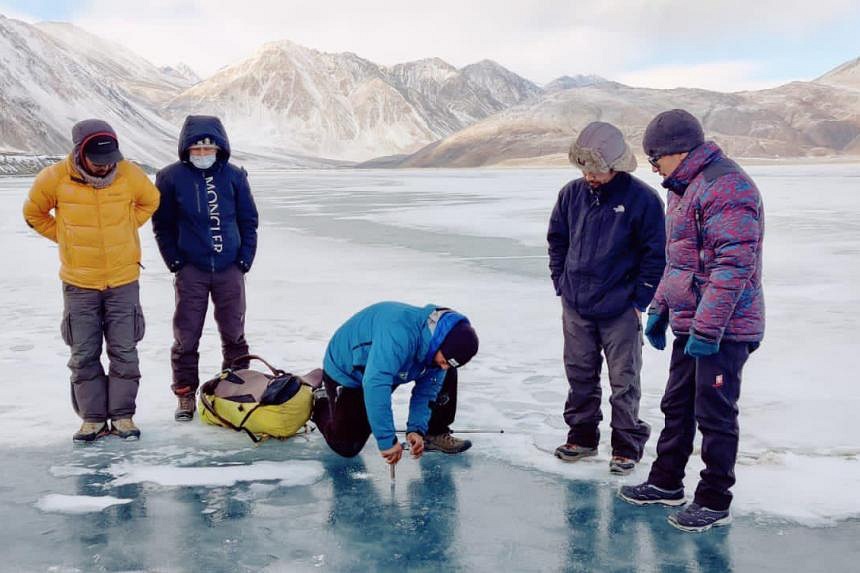NEW DELHI – It is the first-of-its-kind marathon in India. Yet, when runners cover the 21.9km stretch across the frozen Pangong Lake at an altitude of nearly 4,350m in Ladakh, they will be participating in what has been billed as “the last run”.
The Pangong Frozen Lake Marathon, which takes place on Feb 20, aims to highlight the growing vulnerability of the ecologically fragile mountainous region in north India.
A key concern is climate change, which has hastened the melting pace of Himalayan and Karakoram glaciers, rendering the future of locals who depend on its waters at great risk.
“It is this alarming message that we are trying to get across – that this could be the last run,” said Mr Chamba Tsetan, founder of the Adventure Sports Foundation of Ladakh, which is organising the marathon in collaboration with the Ladakh Autonomous Hill Development Council (LAHDC) in Leh district and other local authorities.
Seventy-five runners, including those from India, France, the United States and Britain, will take part in this race that the organisers hope will also secure them an entry into the Guinness World Records for the highest frozen lake marathon.
There are running races in other icy locales, such as the North Pole Marathon, held at sea level, and the Antarctic Ice Marathon, at 700m. Norway organises a frozen lake marathon too – the Icebug Frozen Lake Marathon in Tisleifjorden, located at an altitude of 819m.
The 134km-long Pangong Lake spreads across the disputed Indo-China border. It freezes completely usually by the end of January, when temperatures can drop to as low as minus 40 deg C.
Runners will have the stunning mountainous landscape to inspire them, but they will have to endure frigid temperatures of around minus 10 deg C even while running in bright sunshine.
“Listen to your body,” said Mr Chamba, a professional ice-hockey player, adding that runners must also stay hydrated and warm while running. Hot water points will be available at every 5km of the route. “Keeping the same pace would also help.”
Participants arrived last week in Leh, the region’s biggest city, to acclimatise to the high altitude and cold conditions. They have been advised to wear shoes with cleats to avoid slipping on ice. Medical facilities will be available, with the Indian Army and the Indo-Tibetan Border Police roped in for assistance as well.
Organisers have tried to limit the marathon’s ecological footprint by using composting toilets and banning single-use plastic. Runners will also lodge at home stays in villages to ensure monetary benefits from the event percolate down to the locals.
Mr Tashi Gyalson, chairman of the LAHDC in Leh district, said a key idea behind the marathon is to promote sustainable tourism in rural areas, especially at homestays during off-season winter months.
“We want to ensure tourism in Ladakh is equitably distributed and not just concentrated in particular areas or limited to certain months,” he told ST.
While around 400 applications came in, this figure was pared down to 75 runners to factor in the capacity of home stays in four chosen villages, besides mitigating environmental impact.
The run is being organised at a time of growing concerns about glaciers in the Pangong region.
A December 2021 research study found that the surface of 87 Pangong glaciers had receded by around 6.7 per cent from 1990 to 2019, with experts flagging serious consequences, including the risk of glacial lake outburst floods. One such incident in August 2014 hit Ladkah’s Gya village, destroying houses, fields and bridges.
In the long run, glacial melt beyond a certain threshold will also impact stream flows, reducing the water in them and crippling local livelihoods, said Dr Irfan Rashid, one of the authors of the study. “Glaciers are the backbone of the local economy,” he told ST.

Spread across India and China, the 134km-long Pangong Lake is situated at an altitude of nearly 4,350 metres above sea level. It usually freezes completely by the end of January. PHOTO: @KSTANZINLADAKH/TWITTER
Dr Rashid, a senior assistant professor in geoinformatics at University of Kashmir, said limiting human activity in the “pristine natural environment” is critical to slow down deglaciation because smoke and black carbon deposits on glaciers can enhance melt.
This necessitates robust scientific studies to determine the carrying capacity of the region so that tourism and other human activity is regulated to put the least pressure on the ecosystem.
“The glaciers in Pangong are relatively smaller and their peak point – the threshold beyond which meltwater from them begins decreasing – could come as early as 2040,” he added.



Recommended Comments
There are no comments to display.
Join the conversation
You can post now and register later. If you have an account, sign in now to post with your account.
Note: Your post will require moderator approval before it will be visible.